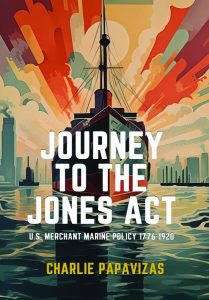‘Godfather Of Maritime Law’ Gives Definitive History of Jones Act
Ninety percent of the world’s cargo is carried by water. Just as marine transportation often goes unseen, so too maritime law can be invisible to those not directly involved with it. Thus, the first volume of a definitive two-volume series on the history of the Jones Act by maritime attorney Charlie Papavizas commands attention.
The Jones Act is the popular name for the Merchant Marine Act of 1920, championed by Sen. Wesley Jones and later supplemented by the Merchant Marine Act of 1936. Papavizas is widely known for his experience with Jones Act laws and the U.S. offshore wind industry. He chairs the maritime practice group at Winston & Strawn LLP. Papavizas has been called “dean of the maritime bar” and “the godfather of maritime law.” Those are bold titles in a field packed with legal minds honed and sharpened in the practice of one of the world’s oldest continuously developed bodies of law.
Papavizas’ recently released book, “Journey to the Jones Act: U.S. Merchant Marine Policy 1776-1920” (Fortis Publishing, Jacksonville, Fla., 2024) is the first volume of what will be a two-part history. It traces the twists and turns of U.S. maritime policy right up until the Jones Act itself. The second volume will take up the story from 1920 through today.
The Jones Act remains a vital underpinning of the U.S. merchant marine that enjoys strong bipartisan support in Congress and among those who care about U.S. naval and maritime policy. Of course, the Jones Act has plenty of opponents, too.
Several consistent threads run throughout the ups and downs of American maritime fortunes and policies. One has been the firm intent of Congress to support cabotage—that is, to reserve coastal and internal shipping to American-built and American–crewed vessels. That policy, called “coastal reservation” in the 19th century, is a major plank of the Jones Act, but it extends back to the 1789 Tariff Acts.
One existing maritime law that still applies today, Papavizas said, might have relevance in today’s tariff disputes. It allows the president on his own authority, without going to Congress, to reduce any existing tariffs by 10 percent for cargoes from overseas carried on American-flagged vessels.
Another continuous thread is the tension between cargo exporters, who usually want the cheapest rate, and American shipbuilders and ship operators, who often argue for various forms of subsidy, support and/or protection from the government. Thanks to America’s high living standard, the cost of shipbuilding and operations has been higher here than elsewhere since about the time of the Civil War. Hence, increasing the number of American-flagged vessels in foreign trade has usually required some form of positive government support, whether direct or indirect.
National security and the role the U.S. merchant marine should play in relation to overall naval policy has been actively debated from our founding, especially as America assumed a greater role in the world beginning with the Spanish-American War.
Papavizas makes the details of long-forgotten battles and controversies come alive for today’s readers. He gives the backgrounds for such pivotal and often colorful personalities as Jones himself, known more in his day for being a diehard Prohibitionist than for the act that bears his name today; William McAdoo, who built subway tunnels in New York, served as Woodrow Wilson’s secretary of the Treasury and then ran as a presidential candidate himself; and Charles W. Morse, the financial fraudster who made a fortune cornering the New York ice market to become the “Ice King,” then formed Eastern Steamship Company to dominate East Coast passenger traffic, earning him the moniker “Admiral of the Atlantic Coast.”
So important has maritime policy been to the American story that it intertwines with much of American history. Debates about whether and how best to support the merchant marine, and how it should relate to naval policy, are often closely related to debates about tariffs, a hot topic again these days.
Any reader who cares anything about the Jones Act will want to keep this book on hand, not only as an enjoyable and compelling read, but as a reference work for background information on maritime policy in general. Each chapter has meticulous reference notes from original documents, in what is clearly a labor of love. Anyone interested in American history—maritime lawyer or not—will also find “Journey to the Jones Act” a rewarding read that can be read through continuously and also dipped into time and time again. It should leave the reader impatiently awaiting Papavizas’ second volume.
“Journey to the Jones Act” is available from Amazon.



